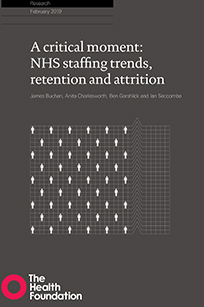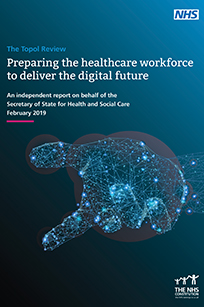News analysis – the workforce problem
The NHS long-term plan recognises that there is a serious issue with staffing – the service needs to address immediate staff shortages and ensure it has a sustainable supply of appropriately qualified staff to draw on going forward.

The Health Foundation’s third annual workforce trends report, A critical moment, acknowledges that staff numbers are increasing overall. England’s 1.07 million staff (full-time equivalent, FTE) – 1.2 million headcount – in place in July 2018 represented an increase of 18,567 (1.8%) compared with 12 months earlier. However, the report stressed that the increase should be seen against a backdrop of more than 100,000 vacancies reported by NHS providers.
Half of the growth is among professionally qualified clinical staff, with ambulance staff, hospital and community health services (HCHS) doctors and scientific, therapeutic and technical staff all growing by around 3%.
However, the number of midwives rose by less than 1%, while the number of nurses and health visitors increased by less than 0.5%.
But of biggest concern is what is happening to staff numbers in the areas being prioritised by the long-term plan. The plan has reiterated the aim to move care out of hospitals and closer to people’s homes, with promises to increase funding for primary, community and mental healthcare services.
Against these priorities, the number of nurses and health visitors working in community services continued a long-term decline, falling by 1.2% (540 FTE). Mental health nursing numbers grew by less than 0.5% (just 170 FTEs), while psychiatrists saw the smallest percentage increase (0.6% or 50 FTEs) among all doctors.
Learning disabilities – another priority area, saw numbers of specialist nurses fall by 3.7% over the same period.
While hospital doctor numbers continued to grow, GP numbers fell by 1.6% in terms of FTEs. However, there was a notable increase in the number of general practice-based pharmacists and advanced practice nurses.
‘Providing more care outside of hospitals is central to the NHS long-term plan, but the health service faces an uphill struggle,’ said Anita Charlesworth, the foundation’s director of research and economics. ‘If it can’t recruit and retain more healthcare professionals in primary, mental health and community care, this will continue to be an unrealised aspiration.
‘There is unfortunately no sign that the long-term downward trend for key staff groups, most notably GPs, will be reversed.’
 Ms Charlesworth said the workforce implementation plan that was currently being worked on would be crucial, but action was needed to address the lack of alignment between staffing and funding, and the damaging impact of wider policy.
Ms Charlesworth said the workforce implementation plan that was currently being worked on would be crucial, but action was needed to address the lack of alignment between staffing and funding, and the damaging impact of wider policy.
‘International recruitment remains vital,’ she said, ‘but it is being constrained by migration policies and the uncertainties of Brexit. We urgently need a coherent strategy.’
NHS Providers’ deputy chief executive, Saffron Cordery, said the growing gap between demand and supply of critical health and care roles such as GPs and community nurses is a concern. ‘We need more immediate actions to ensure staff feel valued and stay within the NHS, and to ensure we can continue to recruit internationally following Brexit.’
While the long-term plan acknowledges the scale of the challenges, the service now needs to see how the NHS and government plan to address these gaps in the short and long term.
On nurse training, the report concluded that the recent changes in funding arrangements in England, combined with a dip in the population of 18-year-olds, had led to a fall in the number of nursing students – not the expected rise. This had been compounded by the attrition rate, with almost a quarter of students across the UK not graduating, or failing to do so within the expected timeframe. There has been no improvement in this attrition rate since 2008 and it was as high as 50% in some universities.
Staff retention must also become a bigger priority as there has been no improvement over the past year. The report says that staff stability – the percentage of staff in a trust at the beginning of a year who remain in their role at the end of it – has decreased substantially between 2010/11 and 2017/18 from 89% to 85%.
over the past year. The report says that staff stability – the percentage of staff in a trust at the beginning of a year who remain in their role at the end of it – has decreased substantially between 2010/11 and 2017/18 from 89% to 85%.
The decline may now have halted – in the past year stability rates have been broadly flat.
However, there is a growing gap between the best and worst trusts and across regions. The stability rate is particularly low in areas of London, where almost one in five staff left their post last year.
This may reflect higher career mobility and a younger workforce, but the report says it may also be exacerbated by the movement of EU staff. Again of concern is the fact that community trusts – at the heart of key policy initiatives – appear to have the worst problems with stability, at 79%, while ambulance trusts were the most stable, at 88%.
The report acknowledges that there is some evidence the decline in stability and turnover can be slowed. NHS Improvement’s retention programme suggests that if boards engage with the issue and focus on retention, they can improve. Some 71% of 110 trusts in the first cohort on the programme have improved turnover rates – reducing turnover by an average of 1.6%.
There are also hopes that greater flexibility for NHS staff – delivered by more self-service features as part of the wider adoption of e-rostering – will also support greater retention.
The report is clear that NHS staffing is failing to keep pace with the level of activity and demand, and in some critical roles such as GPs and community nurses, it is getting worse.
The long-term plan has started to sketch out how some of these issues could be addressed. However, the proposed workforce plan cannot be published soon enough. And the service needs to move beyond simply recognising the issue and start taking actions that increase the retention of existing staff and enable providers to increase recruitment rates.
Staff key to technological future
Digital healthcare technologies – genomics, digital medicine, artificial intelligence (AI) and robotics – will augment healthcare professionals, giving them more time to care for patients. Patient outcomes should improve and patients will be empowered to participate more fully in their own care.
An independent review and report – Preparing the healthcare workforce to deliver the digital future – argues that within 20 years, 90% of all jobs in the NHS will require some element of digital skills and all staff will need digital and genomics literacy.
The review, led by cardiologist, geneticist and digital medicine expert Eric Topol, calls on the NHS to tackle differences in the digital literacy of the current workforce linked to age or place of work.
Complex data governance issues should also be addressed and not be used as a reason for inaction. In addition, mechanisms must be put in place to ensure that advanced technology does not dehumanise care.
Genomics will become integral to all medical specialties and the workforce will be key to ensuring it is efficiently and equitably deployed. Digital medicine will require leadership with the capability to direct the agenda and new senior roles to advise boards on digital technologies. The NHS will also need to build skills in data provenance, curation and governance.
 Artificial intelligence will help to automate mundane repetitive tasks that require little human cognitive power, improve robot-assisted surgery and the optimisation of logistics.
Artificial intelligence will help to automate mundane repetitive tasks that require little human cognitive power, improve robot-assisted surgery and the optimisation of logistics.
NHS bodies should invest in the existing workforce to develop specialist skills, including the commissioning of genomics and digital technologies. Future champions will need to be identified early and the service will need to support portfolio careers in academia and industry.
Completing the digitisation and integration of health and social care records is also a necessary foundation if the service wants to realise the full benefits of digital medicine, says the report.
But the overriding message of the review is the need to recognise that successful implementation will require investment in people as well as technology.
Responding to the report, King’s Fund researcher Harry Evans said that technology was fundamental to some of the most ambitious targets in the NHS long-term plan. Staff will need to be able to use digital tools and understand the data they generate.
‘At a time when staff have never been more stretched, technology has an important role to play in making life easier for over-burdened nurses, doctors and other staff, freeing them up to focus on supporting patients,’ said Mr Evans.
‘As well as training staff to use technology, new systems should be designed to reduce the daily pressures facing NHS workers.’
Related content
The Institute’s annual costing conference provides the NHS with the latest developments and guidance in NHS costing.
The value masterclass shares examples of organisations and systems that have pursued a value-driven approach and the results they have achieved.